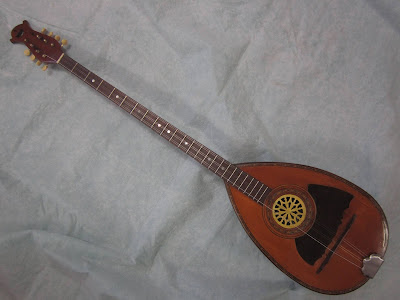The sound of Theodoros Karabas three course bouzouki
The flagship of the 1910s laouto-bouzouka !
How often do you come across an old laouto-bouzouko made by the master luthier of NY Theodoros Karabas?
And if you are lucky enough to view one of his bouzouki creations through high-definition photographs (most of them posted in this blog), how often do you wonder how Theodoros Karabas' bouzoukia really sound ?
Before we answer the last and important question, lets refresh a bit our memory on Karabas life and work.
Theodoros P. Karampas (Θεόδωρος Π. Καραμπάς) born in Vrontama Lakonias (Βρονταμά Λακωνίας) , immigrated to USA in 1894. Became an American citizen in 1904. In one of his trip to Greece in 1911, he married his wife Eugenia. He returned with her and his nephew Panagiotis (son of his brother Georgos) to USA.
He established his musical instrument workshop "Η Νεολαια", before 1910 in
82 St. Mark's Place , at the corner of 8th street and 1st Avenue in NY.
Karampas creations where influenced by laouto and tampoura shapes, counter to A.Stathopoulos bouzouki constructions, whose instruments have been influenced by the mandolin shape.
Also Karampas string length (scale) was 71.5 cm - 72 cm, counter to Stathopoulos and Evagellidis with lenghts at 63cm- 65 cm
Karampas bouzouki instruments can be characterized more closed to laouto-bouzouko, or bouzouko-mana and they have been played originally with raptor feather (as we can confirm from an 1911 NY advertisement by the luthier, who was selling eagle feathers as picks for laouta and bouzoukia.)
Some of the instruments he was producing were :
1. Laouto with 17 staves, carved decoration at the price of 15 $
2. Bouzouki with 17 staves, 8$
3. Bouzouki with 42 staves, stained bowl, and ivory plate , 20$
4. Laouto with 41 staves, stained bowl, and ivory plate, 35$
The master luhtier Chris Pantazelos (http://spartaninstruments.com/) recently restored (back to perfection) an undated Theodoros Karabas laouto-bouzouko with scale 72 cm.
From the label we can estimate that the bouzouki was constructed probably between 1900 and 1920 (more likely 1910s) .
Luckily enough the timing was perfect, as the talented musician Bill Nicholson visited Chris Pantazelo's workshop when the Karabas bouzouki was still there.
Perhaps the only sound clip of a fully restored (back to its original condition) Theodoros Karabas bouzouki on the net! Enjoy!






Comments
Post a Comment